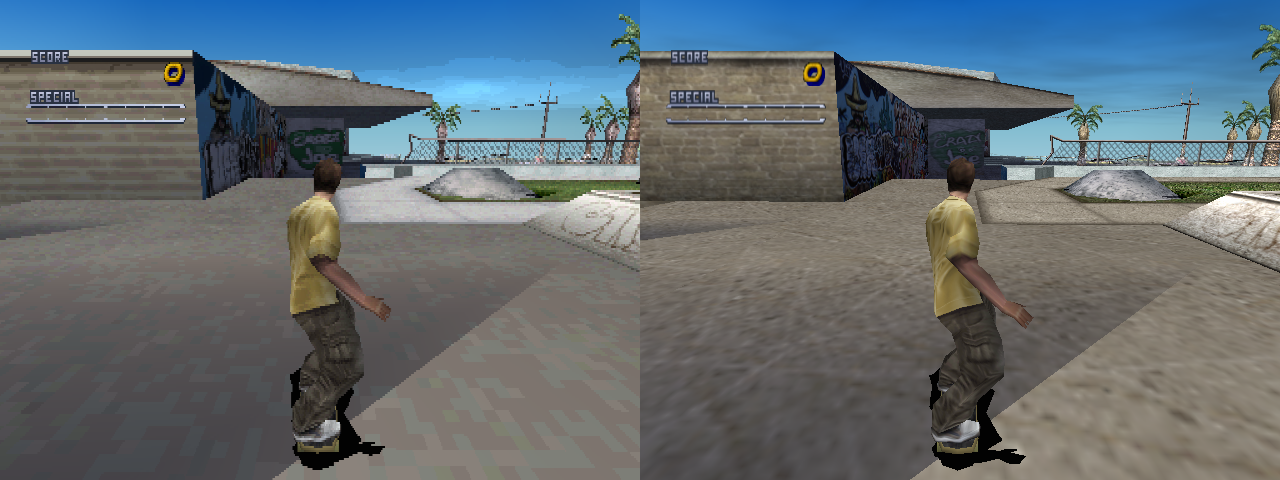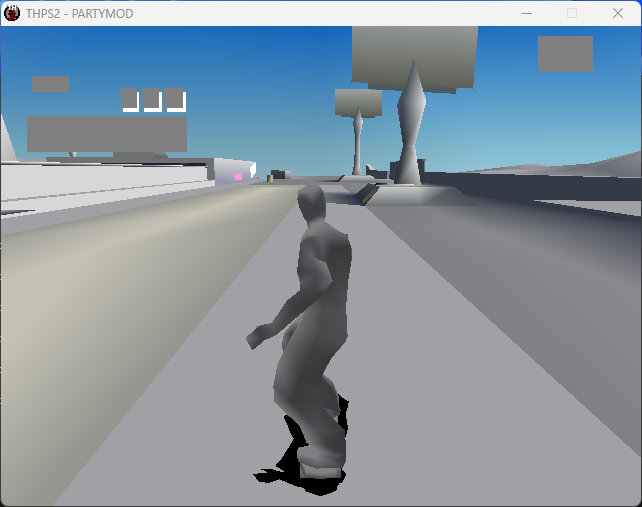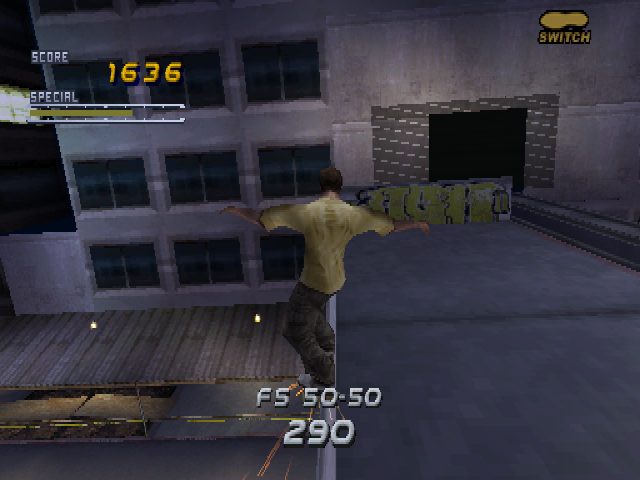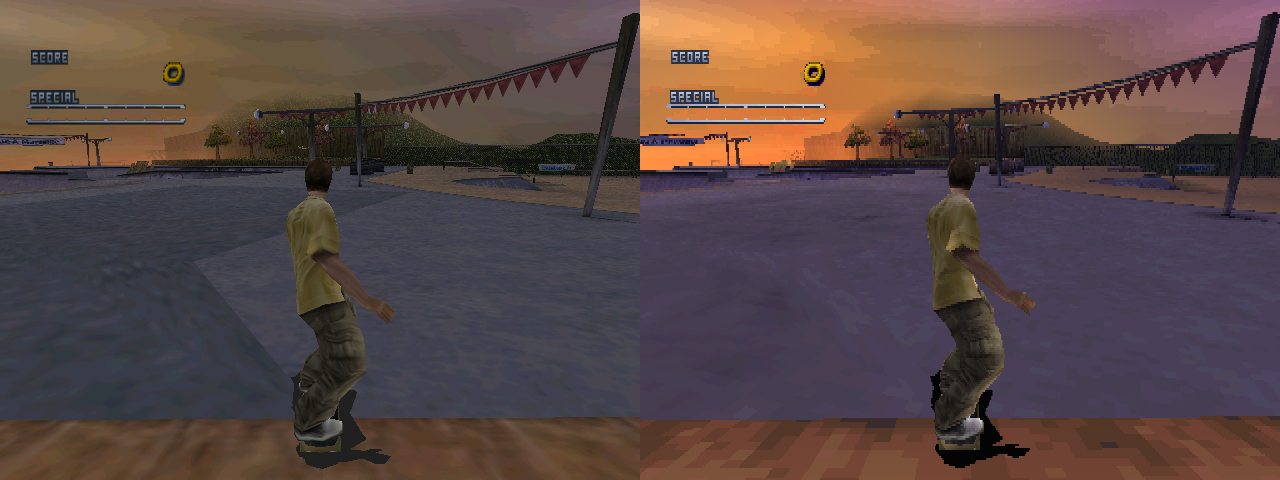▪ Writeup:
PARTYMOD for Tony Hawk's Pro Skater 2
Originally posted May 05, 2024, updated Dec 16, 2024
NOTE: The following was originally posted to Cohost, a site that is going down soon. I added some images to this post, as it originally had none.
For the past couple of months, I've been developing something I'd been scheming about for what looks to be half a year or so, judging by file and commit dates: a modernization patch for THPS2, featuring a new renderer (now using Vulkan instead of D3D7!), among other changes.
Some notes about the process and game itself:
THPS2 was ported to PC by LTI Gray Matter, a studio that specialized in porting games to PC, including a few games based on Neversoft's old 'M3D' (there's no real formal name, but that's what I'll call it. more on that later) engine.
First, to start the whole process of patching the game, I looked around to see what kind of help I could find for reverse engineering. The first resource I found was actually the very first demo of the game, Psy-Q debug symbols managed to leak with a German (iirc) release of the demo. This release looked to be really dated, with its structure matching closer to THPS1, so I looked around a bit more, ultimately discovering that the iOS release of the game also had debugging symbols, and luckily that was also based off the PC release! Additionally I've since learned that apparently the Mac release also didn't have symbols stripped out. Having symbols available was a huge help for navigating the reverse engineering for the project.
Something I found interesting in the credits is that someone is credited for "GTE emulation". That's kind of a theme for this port: all of the matrix math on the PS1 would've been done through its GTE chip, so they recreated that for PC. Past that, they also handle controllers by recreating PS1 controller button structures (this would also be the approach taken for the later PS2 games, those recreate full dualshock 2 packets!), even the mouse support ends up pressing fake buttons (aside from menu selection, which i found odd)! Most importantly, all of the graphics are a sort of emulation of the PS1 GPU:
The renderer is built essentially in two halves: there's one half that performs all transformations, clipping, and ordering (using the original "M3D" functions from Neversoft, presumably the M is for Mick West, programmer and co-founder of Neversoft (now a big-time Skeptic! weird!)), then there's the other half which finally gets those rasterized. The first half talks to the second half through slightly modified PS1 gpu commands (and a sizeable new rendering system involving a special command that we'll get to). All UI and some effects like sparks, dust, and shattered objects are done through original PS1 gpu commands, with a single floating point depth value tacked on to make them work in the depth buffer.
The most important command is 0xB0. On the PS1 it was a blit to VRAM
(iirc), but in THPS2 PC, it's renderDXPOLY(), this is an extra GPU
command that handles all of the actual 3D rasterization in the game. While
the previous commands have vertices specified in integer, this command uses
floating point, basically ready to go directly into direct3d after fog and gamma
correction are applied to vertex colors. It also allows for a flexible number of
vertices, though it only ever renders triangles and quads. Despite having a depth
buffer now, all polygons are pre-sorted by depth.
When translating these commands to Vulkan, I decided on a bindless style structure. All draws get put into a single vertex buffer including position, UVs, vertex color, and texture for each vertex. Textures are all placed into a single array, so that the fragment shader can sample from any texture, depending on vertex data. This allowed me to batch polygon draws even if they had different textures. That is, until i discovered that this causes rendering issues on AMD. Oh well!
Because the new renderer has a depth buffer, Gray Matter needed to do some tricks to get coplanar polygons to display in the correct order: it's not particularly special, but they added a couple depth bias factors, some of which can misbehave and make certain objects appear in the wrong order. Fun!
These sorts of hacks were the name of the game for Gray Matter, who also applied Treyarch's high-resolution textures from the Dreamcast release of THPS2 to the game. These textures aren't baked into each asset file like the PS1 textures, instead the game intercepts textures when loading them into VRAM and replaces them from external BMP files named after the 32-bit CRC of the texture's original file name (Neversoft was a big fan of CRC for hashing, here's Mick West talking about it: https://cowboyprogramming.com/2007/01/04/practical-hash-ids/ ). If the function that replaces the texture data is disabled, the game will just fall back to the PS1 textures.
These textures weren't really designed for the original texture blending algorithm of the PS1 (which multiplies the texture by the vertex color times two), so Gray Matter chose to lighten every surface through a gamma lookup table, which also results in the game looking washed out when compared to the PS1 riginal. This wasn't quite enough for some parts of levels (the skies in Venice Beach and School II, specifically), so Gray Matter also placed some direct modifications to the vertex colors in these levels into the rendering pipeline. With the original texture blending algorithm implemented and with original textures, removing these hacks restored most of the PS1 look of the game.
An issue with the game is that many UI assets were made assuming that the game would be rendering at a 4:3 512x240, making certain things like the game's HUD to be sampled at weird offsets. Now that we had shaders at our disposal, I applied a strategic bilinear sampler so that we could get a sharp 4:3 512x240 without shimmering artifacts from normal nearest neighbor sampling.
Speaking of resolutions, the game has a really interesting inherited trait from PS1: the way that viewports work emulates PS1 exactly. Viewports are always expressed on a 512x512 grid that assumes a 512x240 frame. The viewport shifts by 256 pixels every frame, recreating the double buffering effect they would've used on the PS1 framebuffer.
With the renderer taken care of, I wanted to see if I could fix the crashes the game would regularly run into. Often when loading into the Bullring, the final level, the game would crash. The game leaves behind a log where you can find that the game fails to process some things in the level's trig file (this file is a script that defines what to load into the level). Once I even got it to load, but with absolutely nothing in the level:
There are also a number of other log lines yelling about pointers not being lword-aligned. That seems bad! After some messing with the memory manager, I figured out why this happens: the memory manager is extremely susceptible to memory corruption if out of bounds writes occur.
Memory allocation blocks are handled with all block data existing in the memory pool alongside the blocks themselves. Each block has an eight byte header, where the first byte is its length, and the second is its parent. The parent goes unused when the block is allocated, so memory actually overwrites that portion of the header. It's easy to see how data gets corrupt: when an out-of-bounds write occurs, it's overwriting the next block's header, changing its size. When trying to find where this corruption was occurring, I accidentally made allocations four bytes too large, which happened to fix the corruption problem entirely. How convenient!
There were a couple more common crashes: one would occur when the memory manager ran out of memory. When this happens, the game will enter a while(true) loop. Because the original game would suppress Alt-F4, windows key, and appear in front of almost applications, this made the game near-impossible to exit when it ran out of memory. because of the memory corruption, this would happen pretty regularly if you would speedrun the game. There was one last, unknown crash where D3D would run into an error after playing the final fmv upon completing the game. No idea what caused that, but the renderer rewrite fixed it anyway.
Writing this patch was very fun and is the project that I'm most proud of so far. I'm really happy to have managed to release a Vulkan 1.3 renderer with relatively few problems (other than some AMD crashes cropping up here and there). I hope to get more people into speedrunning this game as it's been one of my favorites in the series, it just feels great to play. anyway that's it go check it out




